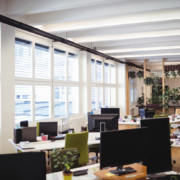Plan for Wellbeing: The Importance of Space Planning
“When you spend eight hours of your day at work, and eight hours at home, there is no reason why your workplace should be any less of a community than your home.” – A Pattern Language, Christopher Alexander, 1977
With recent news that Amazon is pushing to end remote working, we still find ourselves trying to navigate the post-COVID workplace, which makes us think that the importance of space planning for employee well-being has never been more evident. Inspired by the Blue Zone research project and Christopher Alexander’s A Pattern Language, we delve into how thoughtful space design can foster a thriving organisational community.
Space Planning: A Foundation for Wellbeing
Effective space planning goes beyond aesthetics. It’s about creating a physical environment that supports employee well-being and enhances organisational efficiency. By optimising your workspace, you can:
- Foster Community: Encourage collaboration, knowledge sharing, and a sense of belonging among employees.
- Enhance Productivity: Create spaces that enable efficient work and minimise distractions.
- Nurture Employees: Provide a supportive environment that promotes well-being and job satisfaction.
- Optimise Performance: Streamline workflows, reduce waste, and create a more sustainable and efficient workplace.
The Evolving Workplace: A Need for Community and Engagement
The modern workplace has evolved beyond a mere place of work. It’s a hub for collaboration, innovation, and personal growth. Recognising the value of community is crucial for fostering a thriving work environment.
Key Takeaways from A Pattern Language:
- Public Spaces within the workplace: Provide opportunities for social interaction and information exchange.
- Choice and Flexibility: Offer a variety of spaces to accommodate different work styles and preferences.
- Quiet Zones: Create spaces for focused work and uninterrupted concentration.
- Biophilic Design: Incorporate natural elements to enhance well-being and reduce stress.
- Intergenerational Mixing: Encourage collaboration across age groups to foster knowledge sharing and mentorship.
Designing for Human Needs:
To create a truly effective workplace, we must remember that we are designing for people, not just spaces. By incorporating these principles, you can create a workplace that supports social exchanges, encourages engagement, and fosters a sense of belonging.
Conclusion
Space planning is not just about aesthetics; it’s a strategic investment in the well-being of your employees and the success of your organisation. By creating a thoughtfully designed workspace, you can cultivate a positive and productive work culture.
If you’d like to discuss your office space and how ISL might be able to help invigorate it, please get in touch!








Leave a Reply
Want to join the discussion?Feel free to contribute!